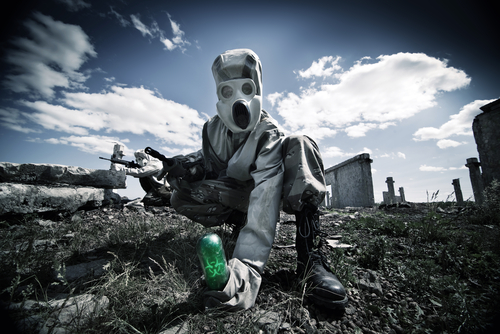Hydrogen sulfide gas is very corrosive and therefore extremely hazardous. You need to take special precautions when choosing equipment and establishing safe work procedures.

Hydrogen sulfide gas is very corrosive and therefore extremely hazardous. You need to take special precautions when choosing equipment and establishing safe work procedures.
All oil and gas well drilling sites should be classified according to areas of potential and or actual exposure to hydrogen sulfide. The recommendations and employee instruction will vary depending on the type of area:
- No Hazard Condition
- API Condition I – Low Hazard
- API Condition II – Medium Hazard
- API Condition III – High Hazard
No Hazard Condition
Any well that will not penetrate a known hydrogen sulfide formation would be categorized as a No Hazard Area. Special hydrogen sulfide–resistant equipment is not required.
API Condition I – Low Hazard
Work locations where atmospheric concentrations of hydrogen sulfide are less than 10ppm. Recommended for these areas:
• Hydrogen Sulfide warning sign with green flag warning device present.
• Keep all safety equipment in adequate working order.
• Store the equipment in accessible locations.
Great news! BLR’s renowned Safety.BLR.com® website now has even more time-saving features. Take our no-cost site tour! Or better yet, try it at no cost or obligation for a full 2 weeks.
API Condition II – Medium Hazard
Work locations where atmospheric concentrations of hydrogen sulfide are greater than 10 ppm and less than 30 ppm. Recommended for these areas:
- Legible hydrogen sulfide warning sign with yellow flag warning device present.
- Keep a safe distance from dangerous locations if not working to decrease danger.
- Pay attention to audible and visual alarm systems.
- Follow the guidance of the operator representative.
- Keep all safety equipment in adequate working order.
- Store the equipment in accessible locations.
- —An oxygen resuscitator.
- —A properly calibrated, metered hydrogen sulfide detection instrument.
API Condition III – High Hazard
Work locations where atmospheric concentrations of hydrogen sulfide are greater than 30 ppm. Recommended for these areas:
- Post legible hydrogen sulfide warning sign with red flag warning device.
- Post signs 500 feet from the location on each road leading to the location, warning of the hydrogen sulfide hazard.
- Check all hydrogen sulfide safety equipment to ensure readiness before each tour change.
- Establish a means of communication or instruction for emergency procedures and maintain them on location, along with contact information of persons to be informed in case of emergencies.
- Ensure usability of two exits at each location.
- Do not permit employees on location without hydrogen sulfide safety training.
Your one-stop safety management resource, available 24/7. Go here to take a no-cost site tour or here to try it in your own office!
- Pay attention to audible and visual alarm systems.
- Store the equipment in accessible locations.
- Two hydrogen sulfide detectors should be present (one should be a properly calibrated, metered detection instrument, and the other should be a pump type with detector tubes. Respiratory protection would be required if periodic testing indicates employee exposures to hydrogen sulfide at concentrations above the PEL.
- —Oxygen resuscitator.
- —Three wind socks and streamers.
- —Two NIOSH/MSHA 30-minute, self-contained breathing apparatus for emergency escape from the contaminated area only.
